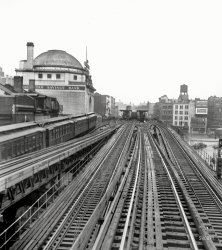
MAY CONTAIN NUTS

Search Shorpy
SHORPY ART

Framed or unframed, desk size to sofa size, printed by us in Arizona and Alabama since 2007. Explore now.
Join and Share
Ad-Free Shorpy
Shorpy is funded by you. Patreon contributors get an ad-free experience.
Learn more.

Recent comments
- Side Winder
- Air Quality?
- Sojourner Truth riot
- None were so blind(ed)
- The less famous sister
- Good ol' days?
- Rise and Fall
- Goo Goo Ga Joob
- Ticket Retention
- Not the only one
- Vagaries of War
- Killed by Amtrak
- Back to the Future
- Wanted --
- If you can't stand the light
- Centralized Traffic Control, I believe
- What's really happening
- Heckuva remote control!
- Sometimes — Things Go Bump!
- I SEE THE LIGHT
- Union Switch and Signal Company
- Get That Light Out Of My Eyes
- Eggs. Eggs. Eggs. The Egg Man is Here!
- Foreboding caption
- Famous Hollywood faces
- Not just S&P
- re: Those things in the jar
- Up In Smoke
- Medical Smoking
- Quick fix
Member Photos
The Shorpy
Print Emporium
Print Emporium
Search Shorpy
Search results -- 30 results per page
- New York Giant: 1908
- ... Forty-five years ago, however, the idea of living in lower Manhattan would have struck almost everyone as strange to the point of ... Posted by Dave - 08/06/2013 - 10:03am -
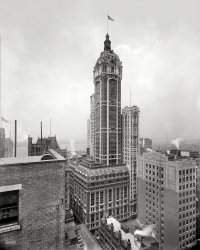
- H Street Market: 1920
- ... until the opening staff retrieved it. If you wander Manhattan around 5:30 AM you will see bags of fresh bread on the sidewalk ... Posted by Dave - 05/17/2014 - 10:23pm -
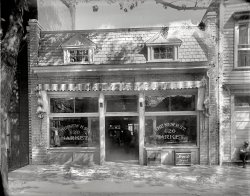
- Fraunce's Tavern: 1900
- ... which figured in the Revolutionary War, is said to be Manhattan's oldest. 8x10 inch dry plate glass negative, Detroit Publishing ... Posted by Dave - 10/11/2012 - 9:31am -
![Fraunce's Tavern: 1900 New York circa 1900. "Fraunce's Tavern, Broad and Pearl Streets." The building, which figured in the Revolutionary War, is said to be Manhattan's oldest. 8x10 inch dry plate glass negative, Detroit Publishing Company. View full size.
An entrance for the ladies?Is the covered entrance under the word Tavern likely a ladies' entrance? I believe all the finest places offered them, providing a more gentile doorway for the more gentile of our species.
[Oy vey. - tterrace]
Which Fraunces?There's good old George Ehret's beer again!
Interesting thing about Fraunces Tavern. The one that George Washington knew, burned in 1854, leaving only one wall. The one seen here, was the rebuild. The Sons of the Revolution, who are still HQ'd here bought the place at the turn of the last century. The owner of this place sold off everything at auction; the sign, the collection of muskets, tables, (Colonial Dames bought up the furniture) flags, mugs etc. thinking they had a fine collection, of historic items. Not a stick of it was authentic to Washington and Fraunces. (See - Fire, above.) The Sons of the Revolution painstakingly reconstructed the Fraunces Tavern of today, the architect utilizing similar extant buildings of the period and presumed original builder, and noting the fire lines and remains of the original floor lines on the only original remaining wall. When the new rebuild opened the public hated it. Why? Because they knew the Fraunces that they remembered, the one pictured here.
+104Below is the same view from November of 2004.
Re: +104Love these shots showing a century of change in buildings and landscape. Noticed that the two side by side buildings lost a floor.
(The Gallery, DPC, Eateries & Bars)](https://www.shorpy.com/files/images/SHORPY_4a29894a.thumbnail.jpg)
- Cockaday and Banning: 1924
- ... Maryland.
1986: Cockaday dies on November 18th in Manhattan, New York. Both he and his wife are buried in Annapolis at St. Marys ... Posted by Dave - 09/13/2012 - 4:20pm -
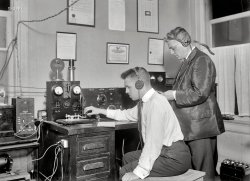
- Times Past: 1906
- Manhattan circa 1906. "Times Building." The recently completed New York Times ... Posted by Dave - 01/21/2019 - 1:30pm -
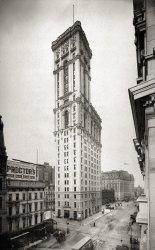
- A Higher Tower: 1919
- ... Church street is the Hudson Terminal of the Hudson and Manhattan Railroad, the current PATH. The Hudson Terminal was demolished to ... Posted by Dave - 08/09/2012 - 7:14pm -
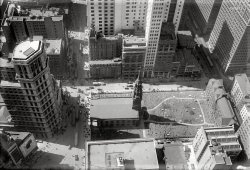
- Memorial Lamppost: 1909
- ... In The Hudson River? No, but the section between Lower Manhattan and New Jersey has been known to develop exposed film plates that ... Posted by Dave - 05/05/2014 - 10:54am -
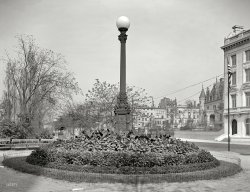
- Got Bread?
- Bread peddlers, East Side Manhattan circa 1915. View full size. 5x7 glass negative. George Grantham ... Posted by Dave - 12/10/2007 - 4:51pm -
![Got Bread? Bread peddlers, East Side Manhattan circa 1915. View full size. 5x7 glass negative. George Grantham Bain Collection.
Fresh breadImagine trying to sell bread like this today, I think the board of health would be shocked
Solarize/preflashThe out of focus images of a few people in the background look almost solarized. Can anyone explain this effect. Could it be an artifact of pre-flashing the film?
Re: Solarize / preflashThe solarized-looking areas are places where the thickest parts of the emulsion are deteriorating, getting darker and flaking on the glass negative, possibly due to mold. On the positive when the image is inverted, the effect is a white outline. There was no flash used. And no film, either.
Ah! that explains it.Thanks. The mystery is solved.
BTW
"Pre-flash" was an old technique of slightly fogging the film in an attempt to soften the image. It predates flash photography.
Secret Agent ManI love the guy peeking around the corner!!
[Also note the kid on roller skates! - Dave]
(G.G. Bain)](https://www.shorpy.com/files/images/22886u.thumbnail.jpg)
- Washington Market: 1812-1912
- ... George McAneny was the President of the Borough of Manhattan from 1909-1913 and then of the Board of Aldermen for New York, ... Posted by Dave - 09/08/2011 - 11:02am -
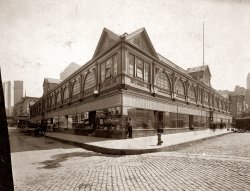
- Ice Dealer: 1941
- ... itself. Old maps label this a gasholder house for the Manhattan Gas Company. It shows up on the earliest map I could find of this ... Posted by Dave - 06/25/2018 - 10:00am -
![Ice Dealer: 1941 December 1941. "Ice man. New York City." Medium format negative by Arthur Rothstein for the Farm Security Administration. View full size.
Alas, Doomed James"Tell of Seeing James Go to Doom in Flight Fight," the headlines scream.
Who among the Shorpyite sleuths might be able to pin down the date of the photograph from this tantalizing little clue?
(Flair enough; the flocus on these phlotographs are always a tad flidgety.)
PushcartsThe ice dealer was one of the few who plied the streets with their carts. The others were gathered into centers where they sold their wares. Mayor LaGuardia housed them in the Essex Street Market. The first pushcarts appeared on Hester Street in 1886. There were 10,000 street vendors at one time in NYC.
Grandpa did thisMy grandfather Anthony Sabbatini was the iceman in East New York, Brooklyn. Known as "Tony the Iceman" for years until he finally got a job with Railway Express, sort of like UPS of the 1930s. He was a strong stocky guy who must have climbed a million stairs delivering ice and packages. A hard life no matter how you look at it.
I still remember:Growing up on Belmont Avenue in the Bronx in the 1940s and seeing the ice man, the coal delivery trucks, the horse-drawn vegetable wagon, and the small wagon with the cage-enclosed merry-go-round for the kids. All going door to door offering their goods and services.
The leaping ramgives away the 1936 Dodge on the right. A universally recognized trademark, it is still in use both in name and image 82 years later.
Maybe ...If those are old newspapers that he's using for wrapping, could the headline refer to the sinking of the Reuben James?
[Yes, and he went down at Madison Square Garden. - Dave]
Looks like the placeWest 18th Street between Ninth and 10th avenues. A most unusual building in a neighborhood rapidly redeveloping itself. Old maps label this a gasholder house for the Manhattan Gas Company. It shows up on the earliest map I could find of this area, 1854, and could be a good deal older than that. An incredible survivor.
(The Gallery, Arthur Rothstein, NYC)](https://www.shorpy.com/files/images/SHORPY-8b16091a.thumbnail.jpg)
- Fall Color: 1910
- ... 1910. "Riverside Drive, New York." A crisp autumn day in Manhattan -- perfect for enjoying nature's tapestry ablaze in a riot of grays. ... Posted by Dave - 09/30/2014 - 11:54pm -
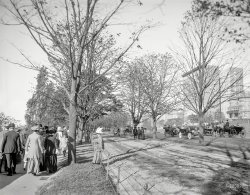
- Radio City: 1939
- ... still a marvel. Few if any buildings that have gone up in Manhattan in the last two decades have any real architectural integrity. More ... Posted by Dave - 10/31/2015 - 4:21pm -
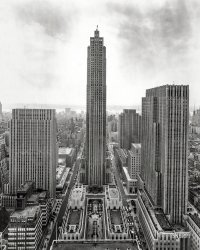
- 23rd Street Piers: 1910
- ... was in use by the railroads before they had tunnels into Manhattan. I think the end of the line was in New Jersey and they brought ... Posted by Dave - 11/01/2019 - 11:07am -
![23rd Street Piers: 1910 Circa 1910. "Twenty-Third Street piers, North River, New York, N.Y." 8x10 inch dry plate glass negative, Detroit Publishing Company. View full size.
Tank wagonI'm sure some Shorpyite out there will know: What's that liquid being discharged from that wagon on the left?
[Dihydrogen monoxide. - Dave]
Oceans of it ...To AD:
She is indeed the Oceanic.
To Dave:
That insidious poison Dihydrogen Monoxide is everywhere! I think Monsanto plays a role. They spray it on the streets. They spray it on plants. Why, it's even here in the drink at my elbow!
Nasty stuff.
The End of the LineI believe this was in use by the railroads before they had tunnels into Manhattan. I think the end of the line was in New Jersey and they brought everybody over to New York on ferry boats. By this time, however, the Pennsylvania RR had a tunnel into NYC and Penn Station, but I think I remember reading that the Erie and Lackawanna Railroads used the ferry from NJ to NYC for a number of years after this.
A White Star LinerThe liner whose funnels and aft masts are barely visible belongs to the White Star Line (the company flag being clearly visible). I am going to make an educated guess that the ship is the SS/RMS Oceanic of 1899. My rationale is there were a limited number of WS ships that sailed to and from New York which was regarded as the most glamorous port on this side of the Atlantic. In 1910 there were five ships assigned the Liverpool/Southampton to New York route. Those were the Oceanic (a one off ship design that had no sisters) and the so called Big Four consisting of the Celtic, Cedric, Baltic and Adriatic. All five were two stackers. But after looking at photos of the ships (Wikipedia is awesome) I believe that the mast closest to the aft most of the smoke funnels is too far forward to be one of the Big Four. That leaves the Oceanic. I tried to match the masts in the photo here with ones from photos of the Oceanic and they are close though not a perfect match. But the difference is so slight it could be attributable to the angle of the photo or simply ordinary maintenance on the masts.
Input from other Shorpy regulars is welcome.
(Add -- The White Star flag was so far down it appeared to me as though it was at half mast. On reflection, I believe that is likely the case. King Edward VII died in May of 1910 and in those days formal mourning was observed for a full year.)
[You're grasping at straws here. This photo could have been taken in any number of years. Neighboring DPC images are from 1908 and 1911. - Dave]
Sorry. I was going by the 1910 in the caption. But if the date could run as far back as 1908, and I am unable to see anything in the image that would narrow the date range, then yeah, it's not possible to be sure what was going on there.
(The Gallery, Boats & Bridges, DPC, NYC, Railroads)](https://www.shorpy.com/files/images/SHORPY-4a25244a.thumbnail.jpg)
- Fifth Avenue: 1911
- ... have greatly outnumbered the automobiles, even in midtown Manhattan. But by 1911, the tide had clearly turned.
(The Gallery, Cars, ... Posted by Dave - 09/08/2017 - 1:29am -
![Fifth Avenue: 1911 New York circa 1911. "Fifth Avenue at West 43rd Street." 5x7 inch dry plate glass negative, Detroit Publishing Company. View full size.
Right-hand drive?So early on the US had right-hand drive cars? Very interesting, would love to know the history surrounding the change.
[A situation often noted in Shorpy photos; in the words of Dave, "Cars of the era were a mix of right- and left-hand-drive. By 1920, most auto makers had settled on left-hand drive." -tterrace]
From wherewould this photo be taken?
[I think a couple of them are heading down the street on the right. -tterrace]
Looking northThis is a view looking north on Fifth Avenue. Virtually everything in this photo has been changed since 1911, with the exception of St. Patrick's Cathedral, the twin spires of which appear in the distant haze on the right. There is today, however, a big pedestal clock on the same (west) side of Fifth Avenue, one block north of its location in the old photo. You can see it on Google Maps, and all of the filigree and other details on the clock appear to be the same as the one in the photo. Perhaps it was moved sometime after 1911? One final note: if this photo had been taken just 5-7 years earlier, the horses and buggies would still have greatly outnumbered the automobiles, even in midtown Manhattan. But by 1911, the tide had clearly turned.
(The Gallery, Cars, Trucks, Buses, DPC, NYC)](https://www.shorpy.com/files/images/SHORPY-4a27525a1.thumbnail.jpg)
- Washington Market: 1956
- ... north along Washington Street at Fulton Street in Lower Manhattan. The market, which began as an open-air bazaar in 1812, was renovated ... Posted by Dave - 09/08/2011 - 8:36pm -
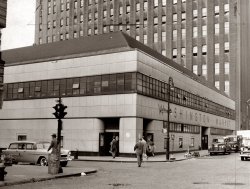
- Bryant Park: 1948
- ... Avenue." With views of the Chrysler Building and other Manhattan landmarks waiting to be named. 4x5 inch acetate negative by John M. ... Posted by Dave - 04/17/2015 - 12:36pm -
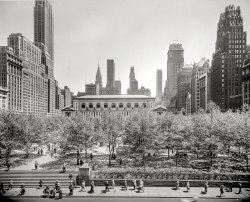
- Union League: 1906
- ... buildings were still on a more human scale, even Midtown Manhattan was Big Sky Country.
Sadly, this gem burned down in 1932. Today, ... Posted by Dave - 02/27/2018 - 1:43pm -
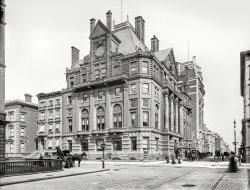
- Downtown: 1962
- March 2, 1962. "New York City views. Downtown Manhattan skyline from the Al Smith houses." 4x5 acetate negative by ... Posted by Dave - 03/16/2017 - 8:56am -
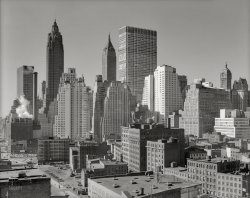
- Guys and Dolls: 1955
- ... in for good measure.
Da Venue Cleanest sewer in all Manhattan.
Stubby's Horse As a very young man in a Marine uniform I ... Posted by Dave - 05/19/2014 - 1:57pm -
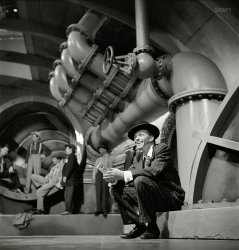
- On the Waterfront: 1900
- ... match.
Does anyone know where this pier was on the Manhattan waterfront?
H.B. Moore Jr. The tugboat H.B. Moore Jr. was part ... Posted by Dave - 04/01/2014 - 8:19am -
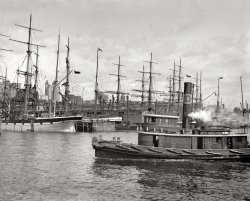
- Busy River: 1904
- ... ugliest bridge. But combined with its neighbors, the Manhattan Bridge and the Brooklyn Bridge, they make an elegant chorus line up ... Posted by Dave - 10/30/2013 - 12:05pm -
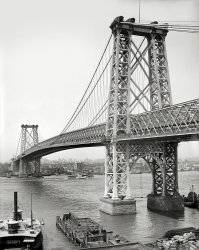
- A Female Drummer: 1898
- ... at the Star Theatre, the Grand Opera House, and the Manhattan Theatre. The opening day cast can be seen here .
Drummer ... Posted by Ken - 07/30/2007 - 1:47pm -
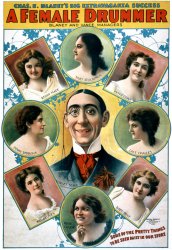
- Strange Leaf: 1908
- ... that the reference to Speedway may be the one in Manhattan that eventually became part of the FDR Drive?
[The Harlem River ... Posted by Dave - 08/19/2012 - 3:44pm -
![Strange Leaf: 1908 May 1, 1908. "Speedway parade. Louis Frank with trotter 'Strange Leaf,' a prize winner." View full size. 5x7 glass negative, George Grantham Bain Collection.
Wacky weed?I wonder what the origin of the name "Strange Leaf" is... although it's no more inscrutible than many modern racehorse names.
Which Speedway?Any possibility that the reference to Speedway may be the one in Manhattan that eventually became part of the FDR Drive?
[The Harlem River Speedway was a 2½-mile dirt trotting track completed in 1898 along the west bank of the river from West 155th Street to West 208th. The stretch from Dyckman to 155th is now a bike trail. - Dave]
Strange LeafStrange Leaf ran in a trotters race at the Speedway on May 10, 1906, against Euchre Prize, Manana, Jabbowok, Teddy K (!), Barbara Smith, and Baron.
I wonder who won?
(The Gallery, G.G. Bain, Horses, NYC)](https://www.shorpy.com/files/images/00350u.thumbnail.jpg)
- A Capitol Photo: 1957
- ... of my rock collecting expeditions in Fort Tryon Park in Manhattan! PS unless you color enhanced your old Anscochrome it looks like ... Posted by tterrace - 04/08/2017 - 3:09pm -
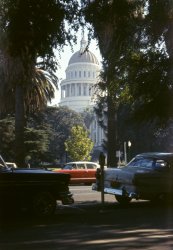
- Alice Under Control: 1908
- ... Brooklyn, across the Brooklyn Bridge, through downtown Manhattan, and then on the ferry to Staten Island. Once near shore, Alice was ... Posted by Dave - 06/26/2016 - 5:28pm -
![Alice Under Control: 1908 New York, 1908. "The end of the rampage -- 'Alice' under control, and thinking it over. Two zookeepers with restrained elephant lying on the ground after running free around the New York Zoological Park (Bronx Zoo)." Gelatin silver print from the William Temple Hornaday papers, Library of Congress. View full size.
More On AliceThe Elephant That Escaped and Swam to Staten Island.
and
Alice Put to Sleep.
Just Wanted Some New SceneryThis was not Alice's only attempt to escape. In June 1904 she was a resident at the Luna Park amusement, and sneaked out of her shed with two other elephants, taking to the river to swim from Coney Island to Staten Island where the New Dorp police took her into custody. (The other two elephants wandered in a different direction and were soon found).
"Press agent or no press agent, we got him, and we are going to keep him till a bondsman shows up," a police officer said, according to printed accounts of the event.
[The press agent would be Luna Park PR man Fred Thompson, who according to contemporary accounts is alleged to have "hired a furniture van to cart the elephant through Brooklyn, across the Brooklyn Bridge, through downtown Manhattan, and then on the ferry to Staten Island. Once near shore, Alice was released into the water." -Dave]
Elephantidae PrecursorHow sad and heartbreaking. It appears that Alice was under-nourished. Perhaps she needed better attention and care.
(The Gallery, Animals, NYC)](https://www.shorpy.com/files/images/SHORPY-08160u.thumbnail.jpg)
- Six-Step Program: 1947
- ... and turban. Orkin took a lot of photos in Harlem and Upper Manhattan. Most likely, the brownstone where this photo was taken is now all ... Posted by Dave - 05/05/2018 - 2:12pm -
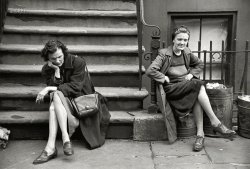
- A Million Stories: 1913
- New York, 1913. "Manhattan looking south along Broadway from Woolworth Bldg." Skyscraper ... Posted by Dave - 01/10/2020 - 12:28pm -
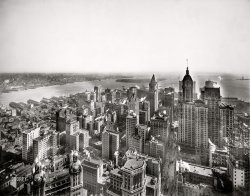
- Meet the Tenants: 1906
- Manhattan circa 1906. "Trinity Building and Broadway, New York." Along with ... Posted by Dave - 10/26/2014 - 10:11am -
![Meet the Tenants: 1906 Manhattan circa 1906. "Trinity Building and Broadway, New York." Along with Trinity Church cemetery and its Independence Memorial Spire. 8x10 inch dry plate glass negative, Detroit Publishing Company. View full size.
The dearly departedThat's a sizable cemetery of the Cathedral of St. John the Divine nestled next to skyscrapers in 1906. Is it still there?
[You are very lost. Try reading the caption! - Dave]
Powerful memories, 105 years laterIn September 2011, I was honored to be part of the Portland (Oregon) Gay Men's Chorus, who was invited to sing a concert at the Cathedral of St. John the Divine to help commemorate the tenth anniversary of the September 11th attacks.
Spending a few days in New York at the time of the anniversary was a memorable and moving trip. Seeing the place where the towers once stood, hearing the stories of survivors and how they escaped and how many of their coworkers didn't make it out, looking at the beautiful new Freedom Tower being built are things that will stay with me for a long time.
One very simple and powerful tribute to the victims of that horrible day was done on the fence of Trinity Church. People were invited to write memories, prayers, and messages on simple white ribbons and tie them to the fence around the cemetery. There were thousands of them, blowing gently in the breeze, a silent reminder of all who were lost. There wasn't a dry eye in our group as we passed them.
One cementary on very expensive real estate.The first thing I thought of on seeing this image was how valuable this small piece of real life history was. Of course, ask 10 people and they would assess its value differently. Donald Trump would love to get his grubby fingers on this one.
Also the work demolishing the building is of interest. One can easily think that the present appetite for destroying (to improve?) is a modern phenomenon.
[A cheaper alternative: the ready-mix cementary. - Dave]
(The Gallery, DPC, NYC)](https://www.shorpy.com/files/images/SHORPY-4a13109a.thumbnail.jpg)
- Alma Sanitarium: 1902
- ... towers in many US cities. (Shorpy has an early view of Manhattan which shows one.)
Next Time, Let's Use Brick By the first ... Posted by Dave - 05/12/2018 - 8:05pm -
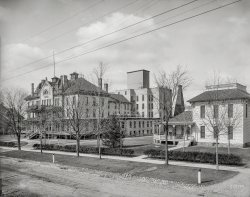
- Bowery Banking: 1947
- New York circa 1947. "Manhattan Savings Bank and Third Avenue elevated tracks." The bank, completed ... Posted by Dave - 03/30/2015 - 2:40pm -
